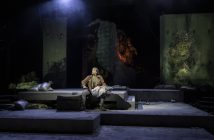For the rest of the year, the Almeida is staging a season of Classical Greek drama. Coolly marketed simply as ‘Greeks’, later on in the year Ben Whishaw is performing in the Bakkhai, and the Almeida’s artistic director Rupert Goold is directing a new version of Medea.
The Almeida is of course known for its bold, innovative productions of the country’s best new writers. It is at the cutting edge of British theatre. So it will be interesting in this new season to see how they turn back time, and strip back the theatre to its ancient roots. If this production of Oresteia is anything to go by, then it promises to be rather special.
Aeschylus’ classic trilogy of the tragic house of Agamemnon is the only surviving trilogy of Greek tragedy. For Ancient Greek audiences, the story of Orestes’ reclaiming his kingdom from his adulteress mother would have been familiar from Homer. The Homeric version of the story sees Orestes as a hero; a paradigm of virtue and a role model for all young men. Indeed, in the Odyssey Telemachus, the son of Odysseus, is told by princes, Kings, and Gods, to be like Orestes.
Audiences would have thus been shocked at Aeschylus’ reworking of the classic myth. Here Orestes is no longer the figure of virtue. The disappearance of Orestes’ mother, Klytemnestra, left ambiguous in Homer, is presented unequivocally in Aeschylus’ tragedy. Orestes kills his mother. Knowingly. In cold blood. His mother bears her breast as he moves to kill her, begging for his mercy. How could he kill the mother who gave him life?
That the court of Athene in the final play is split about Orestes’ verdict, giving him the benefit of the doubt simply highlights the point Aeschylus makes in his original trilogy. We must challenge our role models; for are they really as virtuous as they seem?
In director Robert Icke’s new version, this emphasis on ambiguity remains, but it shifts away from focussing on Orestes’ own virtue and instead challenges the overall notion of moral absolutism.
By staging the original story’s prequel, which is not in Aeschylus’ trilogy, namely the sacrificial killing of Iphigeneia by Agamemnon in return for good winds and victory in war, Icke starkly opens up the cycle of killings that is played out in the Oresteia. In doing so he adds colour to the characters, bringing out their faults, their desires, and their motivations. Agamemnon is no longer the wronged war hero, but a man of fanatic religious conviction, which leads him to kill his only daughter. Klytemnestra is no longer the conniving adulteress, but a wronged mother, who takes revenge on her daughter’s murderer. Through Icke’s Agamemnon and Klytemnestra we see the concrete foundation of Orestes’ tragic condition. We understand how self-righteousness has torn through his family, leaving him traumatised.
This trauma is in turn emphasised by the production’s clever framing of events through a series of psychological investigations between Orestes and his doctor. The play is played out through scenes that he remembers. These fragmentary memories serve not only to demonstrate the extent of Orestes’ condition, but also to underscore the play’s emphasis on moral ambiguity. After all, how are we truly to know what Orestes really saw, or what he really felt? Does the court of Athene free a psychotic madman, or a traumatised unfortunate?
The minimalist and stylish staging helps us focus on this complexity. Large, transparent sliding doors that can suddenly turn opaque, frame the play’s action, both visually, in the sense of a photograph, and figuratively, in the way that our eyes are only witness to what we are allowed to see. The stage’s graduating tiers which lead to a monolithic, freestanding bath, also imply a sense of inner sanctum – an area cut off from our gaze.
One interesting effect of Icke’s adaptation is also to emphasise the part of Klytemnestra. By staging the prequel, and creating more fully formed characters, we now question Klytemnestra in the same way we do Orestes. Was she right to take revenge on Agamemnon for the killing of their daughter? And indeed how can she kill the man she loves?
Of course in the original story Klytemnestra has already shacked up with Agamemnon’s cousin Aegesthus by the time he comes back from war. She kills him not only to revenge her daughter, but also so she can reign over the kingdom and be with her new lover.
But this isn’t the case in Icke’s version. Instead Klytemnestra only starts her relationship with Aegesthus after she’s killed Agamemnon – and in a clever staging move, Aegesthus is played by the same actor as Agamemon. Icke is suggesting that Klytemnestra replaces Agamemnon with a man in the same image as him emphasising that she still loved him.
This newly expanded Klytemnestra is played with astonishing anguish and pathos by Lia Williams. She presents us with a complex imagining of the wronged mother. A performance that appreciates her place as a political figure, as the wife of Agamemnon, as the mother of her children, but most of all as a woman; and particularly as a woman in a society where her voice is tragically ignored with the death of her daughter,
Indeed with this performance Williams makes Klytemnestra the focus of the Oresteia. We are shown that this is the tragedy of a wife and a mother, when these two roles, both rooted in love, become mutually exclusive.
In the promotional material for Greeks the Almeida’s Rupert Goold writes that the Greeks ‘took society’s old myths and made them new…we want to follow their example’. This first production in the season certainly achieves the Almeida’s objective. Powerful and intelligent, it makes the Ancients relevant, while remaining full of artistic and intellectual integrity. I eagerly await the rest of the season.
Oresteia runs at The Almeida Theatre until 19th July. For more information, including details of the rest of the Greek festival programme, visit www.almeida.co.uk.




